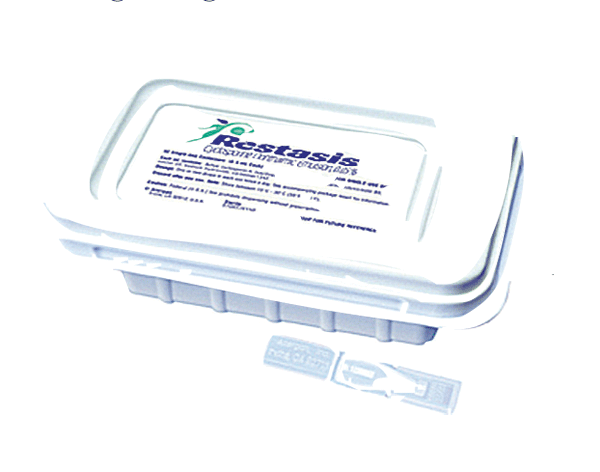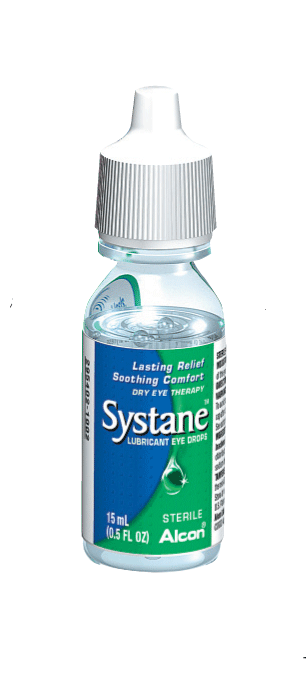George Ousler, Ciera Maffei,
The American history of dry-eye treatment likely dates back to the days of the traveling medicine show. Once commercialized solutions became available, Wyeth's Collyrium and Ross' Murine were prominent early on, and Liquifilm (Allergan) and Tears Naturale (Alcon) were soon to follow. Between 80 and 115 different over-the-counter ophthalmic formulations are currently available on pharmacy shelves across the
Here's a look at how decades of trying to perfect the remedy for tear-film insufficiencies have led to the dry-eye diagnostics and therapies used today.
Tear-film Complexity
The human tear film is typically described as having mucin, aqueous and lipid components. At a more complex level, the tear film is composed of electrolytes (e.g., sodium, chloride), antioxidants (e.g., vitamin C, glutathione), anti-infectives (e.g., lactoferrin, lysozyme), immune and inflammatory proteins (e.g., sIgA, IgG, IL-2), proteins involved in tear-film maintenance (e.g., lipocalins, mucins), proteins involved in corneal wound healing and maintenance (e.g., fibronectin, TGF-alpha, insulin), neuropeptides (e.g., calcitonin gene-related peptide, subP) and lipid components (e.g., wax esters, cholesterol esters).2-4 These tear-film components originate from a variety of sources, including the lacrimal glands, ocular surface cells, nerve endings and meibomian glands.
The concentrations of these components vary drastically from one tear film to another, and deficiencies in an individual's quality or quantity of the components can lead to dry eye.
Furthermore, the complex solution formed by all of these ingredients is constantly being wiped from the ocular surface and replenished with every blink. Study of the biomechanics of the blink has resulted in a better understanding of the forces at work.
Fluid-fluid cohesive forces, fluid-solid adhesive forces, the polarities of surface molecules and surfactants—surface-active agents capable of increasing the wettability of a surface by bridging polar and nonpolar molecules—can all affect the net wettability of the tear film.5 With the durations of the opening and closing phases of the blink as much as 82 and 176 ms, respectively, and maximum velocities of 19 and 9.7 cm/s, respectively, the tear film regularly undergoes rapid and dynamic changes.6 Visually intensive situations such as working on a computer, reading and driving at night can all contribute to hyper-stressed tear film states due to insufficient blinking frequency.
Through everything, the tear film must also provide the proper refractive index to maintain optical clarity. In short, the milieu of natural tear-film traits and requirements amounts to an immense challenge for human attempts to mimic it.
When the integrity of the tear film is breached as a result of either internal or external factors, the ocular surface can be exposed and vulnerable to environmental insults during a patient's inter-blink intervals (IBIs). Though more knowledge regularly surfaces regarding the causes and pathophysiologies of dry eye, the challenge of treatment on an individual basis remains. Often, clinical signs and symptoms of dry eye don't agree, confounding proper diagnosis and treatment.
Parallel to the advances in tear formulations, diagnostic methodologies often play instrumental roles in the success of dry-eye products. The relationship is often symbiotic in nature: Ophthalmic product development drives diagnostic advances and helps to educate the public, while the emergence of the diagnostic test helps to provide a scientific basis for the product's mechanism. Furthermore, the development and usage of these instruments has led to the battery of diagnostic tests available to practitioners today.
Tear-film Breakup Time
Tear-film breakup time is a familiar ophthalmic term today but was only established about 30 years ago. Though the phenomenon of tear-film breakup was described in the early 1900s, the bulk of reports on TFBUT as a clinical entity emerged in the late 1960s and early 1970s, defining the measurement as the time from the last complete blink to the formation of the first dry spot.7 In 1975, a report was published demonstrating the effects of a new tear substitute (Tears Naturale, Alcon) on TFBUT, lasting 90 minutes post-instillation.8 The authors also theorized that a longer TFBUT corresponded to enhanced tear-film stability, a notion that has persisted over the last three decades.

The TFBUT diagnostic has also maintained its position as a valuable tool for evalutating tear-film stability and certain research has enhanced the scientific application and interpretation of it. Testing determined the influence of the volume of fluorescein instilled on the accuracy of the measure, and later studies established the enhanced treatment effect when ophthalmic agents are instilled after TFBUT.9 Today, TFBUT serves as an efficacy endpoint in many treatment studies of newer artificial tear solutions as well as therapies in development.10,11 It has also led to the emergence of further evaluation of the dynamics of breakup, as observed in the measure of tear-film breakup patterns.12
The Preservative Debate
The concept of a disappearing preservative was next on the scene with the release of GenTeal eye drops (Novartis, originally marketed by CIBA Vision). The preservative in the formulation, sodium perborate, is an oxidative preservative that is converted to hydrogen peroxide upon contact with water.13 Thus, the term "disappearing preservative" denotes the ability of the preservative to quickly decompose to water and oxygen when it reaches the ocular surface.14 The mechanism of the preservative positioned the product as a more "gentle" tear, and was pivotal in the creation of the GenTeal line. Stabilized oxychloro complex, also known as Purite, is another oxidative preservative and is used in Refresh Tears (Allergan).
Due to advantages and disadvantages of the formulations on either side of the debate, preserved and unpreserved tears are both available today. Furthermore, the concern for preservative toxicity generally only pertains to patients who use ocular lubricants in conjunction with other therapies (e.g., glaucoma treatment), those using drops post-LASIK surgery and those who require frequent dosing, as we discussed in our May 2002 column, "The Downside of Tear Preservatives."
The Role of pH
Soon after the 2002 FDA-approval of Allergan's Restasis (cyclosporine A) as the first prescription eye drop for decreased tear production, Alcon launched Systane Lubricant Eye Drops, a tear that brought yet another unique mechanism to light. The pH-driven polymerization mechanism of action of Systane is the secret to its effectiveness, but much of the evidentiary support for this tear was provided by a new diagnostic tool—the Ocular Protection Index. The OPI is calculated by dividing the patient's TFBUT by his IBI measurement (in seconds): an OPI <1.0 denotes insufficient ocular surface protection between blinks, while an OPI value of 1.0 or greater indicates that the tear film provides sufficient ocular surface protection between blinks.15 The metric therefore allows investigators to examine the level of ocular surface protection afforded by a patient's natural tear film, as well as the effect of artificial tears on this protective ability. Research on Systane demonstrated a prolonged effect on OPI improvement in addition to TFBUT.16

Targeting the Lipid Layer
A tear purported to be the "first multi-dose, emollient-based lipid restorative tear" emerged with Alimera Sciences' launch of Soothe in 2005 (now marketed as Soothe XP). The foundation of this tear is its ability to bolster the lipid components of the tear film via the lipid emulsion formulation. (Greiner JV, et al. IOVS 2005;46:ARVO E-abstract 2035) The entity of lid-wiper epitheliopathy was integral in documenting the effects of this tear. Lid-wiper epitheliopathy is used to describe the phenomenon of alteration of the epithelium by the portion of the lid margin that interacts with the ocular surface during a blink—the lid wiper—and is observable via staining. (Korb DR, et al. IOVS 2002;43:ARVO E-abstract 55) Research on Soothe demonstrated its ability to reduce the severity of lid-wiper epitheliopathy and associated symptoms by augmenting the lipid layer. (Herman JP, et al. IOVS 2005;46:ARVO E-abstract 2017) Soothe was also shown to increase mean lipid layer thickness significantly more than other formulations in a paper17 and a presentation at a meeting of the Association for Research in Vision and Ophthalmology. (Korb DR, et al. IOVS 2005;82:ARVO E-abstract 2036)
Addressing Visual Function
The latest ocular lubricant-diagnostic duo emerged with the introduction of Systane Ultra Lubricant Eye Drops. It's the first tear to try to address the visual function implications of dry eye. Research has acknowledged the importance of visual function and the quality-of-life implications of decreased vision in dry-eye patients, but the ability to measure these effects in a standardized way has been enhanced with advanced tools.
The Inter-blink In-terval Visual Acuity Decay (IVAD) test, for example, measures the visual function degradation that occurs between blinks and quantifies the amount of time until a subject's visual acuity decays after a blink. Studies utilizing the IVAD test showed differences in visual function parameters between dry-eye patients and normals and have helped determine the correlation between central corneal staining and visual function in patients with dry eye. (Walker P, et al. IOVS 2007;48:ARVO E-abstract 422; Ousler GW, et al. IOVS 2007;48:ARVO E-abstract 410) Results of a recent clinical trial sponsored by Alcon using the IVAD model demonstrate enhanced visual function abilities 90 minutes post-instillation of the formulation. (Torkildsen G, et al. IOVS 2009;50:ARVO E-abstract 4649) Systane Ultra contains the active ingredients found in its predecessor, but it also includes sorbitol and is formulated at a pH of 7.9, changes which may minimize blurring upon instillation.
Exciting prospects for future dry-eye therapies with novel mechanisms are on the horizon, as well. EyeGate Pharma recently completed a Phase II clinical trial of EGP-437 using Ora's Controlled Adverse Environment model. The combination drug and device employs an iontophoretic delivery system called EyeGate II to deliver a corticosteroid solution, focusing on delivery through the sclera, and demonstrated significant improvements in signs and symptoms of dry eye during and after CAE exposure.18 Resolvyx Pharmaceuticals has a novel agent in Phase I/II clinical development in patients with moderate-severe dry eye. The agent is a synthetic analog of a naturally occurring class of small-molecule lipid mediators with anti-inflammatory properties called resolvins.19
Dr. Abelson, an associate clinical professor of ophthalmology at
1. Ophthalmic drug products for over-the-counter human use; final monograph. Federal Register. 1988;53:43:7076-93.
2. Stern ME, Beuerman RW,
3. Gipson IK. The ocular surface: The challenge to enable and protect vision. Invest Ophthalmol Vis Sci. 2007;48:10:4391-8.
4. Butovich IA, Millar TJ, Ham BM. Understanding and analyzing meibomian lipids—a review. Curr Eye Res. 2008;33:5:405-20.
5. Abelson MB, Doane MG, Ousler G. Tear film and blink dynamics. In: Albert DM, Jakobiec FA, eds. Principles and Practice of Ophthalmology.
6. Doane MG. Interaction of eyelids and tears in corneal rewetting and the dynamics of the normal human eyeblink. Am J Ophthalmol. 1980;89:507.
7. Dohlman CH. The function of the corneal epithelium in health and disease. Invest Ophthalmol. 1971;10:6:381-407.
8. Lemp MA, Goldberg M, Roddy MR. The effect of tear substitutes on tear film break-up time. Invest Ophthalmol. 1975;14:3:255-8.
9. Abelson MB, Ousler GW III, Nally LA, et al. Alternative reference values for tear film break-up time in normals and dry eye populations. Adv Exp Med Biol 2002;506(Pt B):1121-5.
10. Ousler GW, Michaelson C, Christensen M. An evaluation of tear film breakup time extension and ocular protection index scores among three lubricant eye drops. Cornea 2007;26:8:949-52.
11. Clinical Pharmacological Study of AL-43546 Ophthalmic Product in Subjects with Shortened Tear Film Break Up Time. http:// www.clinicaltrials.gov/ct2/show/NCT00760045?term=tear+film+break-up+time&rank=2. Accessed 8 April 2009.
12. Ousler III GW, Lemp MA, Schindelar MR, Abelson MB. Tear Flim Break-Up Patterns (TFBUP)—A Method of Measuring Tear Film Stability. Ocular Surface 2005;3:1:suppl.
13. Noecker R. Effects of common ophthalmic preservatives on ocular health. Adv Ther. 2001;18:5:205-15.
15. Ousler GW, Wilcox Hagberg K, Schindelar, et al. The ocular protection index. Cornea. 2008;27:5:509.
16. Ousler GW, Clifford M, Christensen M. An evaluation of tear film breakup time extension and ocular protection index scores among three marketed lubricant eye drops. Cornea. 2007;26:8:949-52.
17. Scaffidi RC, Korb DR. Comparison of the efficacy of two lipid emulsion eyedrops in increasing tear film lipid layer thickness. Eye Cont Lens. 2007;33:1:38-44.
18. EyeGate Pharma. www.eyegatepharma.com/pdf/news2009
19. Resolvyx Pharmaceuticals. http://www.resolvyx.com/news-pubs/releases/122008.asp



